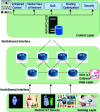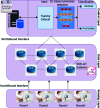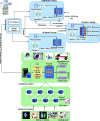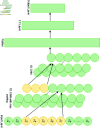AI-Driven fetal distress monitoring SDN-IoMT networks
- PMID: 40743297
- PMCID: PMC12313076
- DOI: 10.1371/journal.pone.0328099
AI-Driven fetal distress monitoring SDN-IoMT networks
Abstract
The healthcare industry is transforming with the integration of the Internet of Medical Things (IoMT) with AI-powered networks for improved clinical connectivity and advanced monitoring capabilities. However, IoMT devices struggle with traditional network infrastructure due to complexity and eterogeneous. Software-defined networking (SDN) is a powerful solution for efficiently managing and controlling IoMT. Additionally, the integration of artificial intelligence such as Deep Learning (DL) algorithms brings intelligence and decision-making capabilities to SDN-IoMT systems. This study focuses on solving the serious problem of information imbalance in cardiotocography (CTG) characteristics with clinical data of pregnant women, especially fetal heart rate (FHR) and deceleration. To improve the performance of prenatal monitoring, this study proposes a framework using Generative Adversarial Networks (GAN), an advanced DL technique, with an auto-encoder model. FHR and deceleration are important markers in CTG monitoring, which are important for assessing fetal health and preventing complications or death. The proposed framework solves the data imbalance problem using reconstruction error and Wasserstein distance-based GANs. The performance of the model is assessed through simulations performed using Mininet, according to criteria such as accuracy, recall, precision and F1 score. The proposed framework outperforms both the basic and advanced DL models and achieves an effective accuracy of 94.2% and an F1 score of 21.1% in very small classes. Validation using the CTU-UHB dataset confirms the significance compared to state-of-the-art solutions for handling unbalanced CTG data. These findings highlight the potential of AI and SDN-based IoMT to improve prenatal outcomes.
Copyright: © 2025 Ullah et al. This is an open access article distributed under the terms of the Creative Commons Attribution License, which permits unrestricted use, distribution, and reproduction in any medium, provided the original author and source are credited.
Conflict of interest statement
The authors have declared that no competing interests exist.
Figures
















Similar articles
-
Intermittent auscultation (IA) of fetal heart rate in labour for fetal well-being.Cochrane Database Syst Rev. 2017 Feb 13;2(2):CD008680. doi: 10.1002/14651858.CD008680.pub2. Cochrane Database Syst Rev. 2017. PMID: 28191626 Free PMC article.
-
Cardiotocography versus intermittent auscultation of fetal heart on admission to labour ward for assessment of fetal wellbeing.Cochrane Database Syst Rev. 2017 Jan 26;1(1):CD005122. doi: 10.1002/14651858.CD005122.pub5. Cochrane Database Syst Rev. 2017. PMID: 28125772 Free PMC article.
-
Continuous cardiotocography (CTG) as a form of electronic fetal monitoring (EFM) for fetal assessment during labour.Cochrane Database Syst Rev. 2017 Feb 3;2(2):CD006066. doi: 10.1002/14651858.CD006066.pub3. Cochrane Database Syst Rev. 2017. PMID: 28157275 Free PMC article.
-
An ensemble of deep representation learning with metaheuristic optimisation algorithm for critical health monitoring using internet of medical things.Sci Rep. 2025 Aug 10;15(1):29241. doi: 10.1038/s41598-025-15005-9. Sci Rep. 2025. PMID: 40784985 Free PMC article.
-
XAI-XGBoost: an innovative explainable intrusion detection approach for securing internet of medical things systems.Sci Rep. 2025 Jul 1;15(1):22278. doi: 10.1038/s41598-025-07790-0. Sci Rep. 2025. PMID: 40594692 Free PMC article.
References
-
- Chaudhary RK, Kumar R, Aurangzeb K, Bedi J, Anwar MS, Choi A. Enhancing clustered federated learning using artificial bee colony optimization algorithm for consumer IoT devices. IEEE Trans Consum Electron. 2024.
-
- Anwar MS, Alhalabi W, Choi A, Ullah I, Alhudali A. Internet of metaverse things (IoMT): applications, technology challenges and security consideration. Future communication systems using artificial intelligence, internet of things and data science. CRC Press; 2024. p. 133–58.
-
- Ahmad HF, Rafique W, Rasool RU, Alhumam A, Anwar Z, Qadir J. Leveraging 6G, extended reality, and IoT big data analytics for healthcare: a review. Comput Sci Rev. 2023;48:100558. doi: 10.1016/j.cosrev.2023.100558 - DOI
MeSH terms
LinkOut - more resources
Full Text Sources

